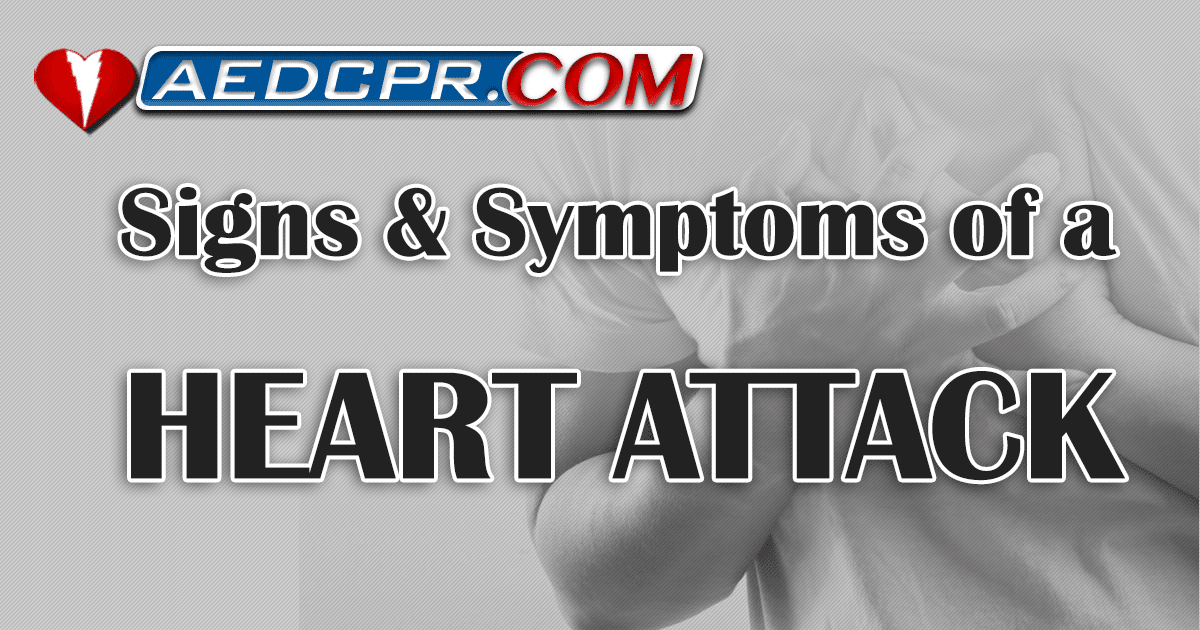
In the United States, a heart attack occurs every 40 seconds. Recognizing the signs and symptoms of a heart attack as soon as possible can help save lives.
What is a heart attack?
A heart attack (also known as myocardial infarction) occurs when blood flow to the heart stops or becomes severely restricted, depriving the heart of much-needed oxygen. As a result, the part of the heart muscle deprived can die without treatment.
Most of the time, heart attacks are caused by a blockage such as a blood clot, or plaque in the arteries (atherosclerosis). Because of this, heart attacks are often treated with blood thinners and other medications to alleviate the blockage and restore blood flow to the heart.
Heart attack or cardiac arrest?
You might have heard these terms used interchangeably, but they actually refer to two different conditions.
While a heart attack is caused by reduced blood flow, cardiac arrest occurs when the heart malfunctions and stops beating properly. Specifically, it is caused by an irregular heartbeat (arrhythmia) that disrupts the heart muscle’s ability to pump blood throughout the body. It also occurs when the heart stops beating entirely, with no arrhythmia or activity.
During sudden cardiac arrest, the victim will lose consciousness and become unresponsive. Death can occur within minutes if the condition is not treated as soon as possible.
Even though a heart attack and cardiac arrest are two different conditions, they are linked. While most heart attacks don’t lead to cardiac arrest, many cases of sudden cardiac arrest are caused by a heart attack.
Do you know the symptoms?
When most people hear the words “heart attack” they think of a sharp pain in the chest. Many people compare the sensation to the feeling of an elephant sitting on your chest.
While pain or discomfort in the chest is common, they’re not the only symptoms. In fact, other areas like the arms or head may be affected during a heart attack too.
The major signs and symptoms of a heart attack are:
- Pain or discomfort in the chest sometimes referred to as Angina. This symptom is often described as a “crushing” pain rather than as shooting pain. It is often compared to the feeling of having an elephant sit on your chest, and it can last for several minutes. The pain is constant, as opposed to a shooting pain that comes and goes.
- Pain or discomfort in the neck, jaw, arms, shoulders or back. Although it’s not as common as chest pain, you may feel a “squeezing” pain in these areas during a heart attack.
- Feeling weak or faint. Feeling dizzy, or like your heart is racing are common symptoms.
- Difficulty breathing. Shortness of breath is common when the heart can’t pump enough blood through the lungs.
- Profuse sweating, with no apparent cause.
- Cold, clammy skin. The skin is the largest organ in the human body. When a person is in distress or dying, the skin will usually shut down first in order to preserve the heart and brain.
- Cyanotic or ashen color. The lips will usually change color first. In patients with light skin, lips will appear blue. In patients with dark skin, the signs can be more difficult to spot, and the lips will appear gray or white. Additionally, eyes may appear somewhat gray or pink.
Heart attack symptoms in women
Women may experience heart attack symptoms differently than men. While women usually still experience chest pain or discomfort, they are more likely to experience:
- Nausea
- Shortness of breath
- Pain in the neck or jaw
- Fullness or pressure in the chest
The symptoms that women experience can be more subtle than those experienced by men. In some cases, the symptoms of a heart attack can be mistaken for something less serious like acid reflux, or the flu.
Cardiovascular diseases are often thought of as a health issue that affects men. In reality, it is the single leading cause of death in women over the age of 25. Women are less likely to seek treatment if they only experience less likely symptoms.
Not all heart attacks are the same
While the symptoms listed above may be common, a heart attack victim may experience some of them but not others.
Conditions with similar symptoms
Sometimes people do not seek medical treatment when they are showing signs of a heart attack because they mistake the symptoms for something else. In some cases, a heart attack can be mistaken for:
- Indigestion
- Acid Reflux
- Cold or Flu
- Heartburn
What to do in the event of a heart attack
A heart attack can be a life-threatening situation, and quickly recognizing one can make a difference. The fastest way to get help in the event of a heart attack would be to call 911.
Every minute matters in an emergency. Even if you’re not sure it’s a heart attack, it is better to act quickly and call an ambulance anyway. Furthermore, it is easier to treat a heart attack than cardiac arrest.
Emergency Medical Technicians (EMTs) can treat a heart attack victim as soon as they arrive. For example, EMTs can administer oxygen if you have low levels of oxygen in your blood, or a glyceryl trinitrate (GTN) to thin the blood. In addition, EMTs will have a defibrillator in case of cardiac arrest.
You can be treated quickly at the hospital if you arrive by ambulance as opposed to being driven there. Furthermore, if the heart attack turns into cardiac arrest, you won’t be able to get treatment in a car.
Getting treatment quickly increases the chance of survival and reduces the chance of long-term complications. Therefore, the best course of action in the event of a heart attack is to call for an ambulance.
Who is at risk?
There are many factors that can increase the chances of having a heart attack. The more of them that apply, the higher the risk:
- Being overweight or obese. Studies have shown that people classified as obese or overweight are more likely to have a heart attack.
- High cholesterol. In particular, high levels of low-density lipoprotein cholesterol (LDL) can cause narrowing of the arteries. In addition, high triglyceride levels can also increase your risk.
- Diabetes. People with diabetes are more likely to experience cardiac disease. Controlling blood sugar levels is an effective way to reduce your risk of a heart attack.
- Tobacco usage. The chemicals in tobacco smoke can damage more than your lungs. Not only that, but they can also damage your heart and blood vessels, increasing the risk of atherosclerosis; a disease that causes plaque to build up and block arteries. Even secondhand smoke is a risk factor.
- High blood pressure (HBP) can increase your risk as well. If left untreated, it can cause damage to the arteries.
- Sedentary lifestyle. People who have sedentary lifestyles engage in little to no physical activity. This inactivity can contribute to high blood pressure and cholesterol. In other words, people who exercise and move around more are at lower risk.
- Age. Men over the age of 45 and women over the age of 55 are more likely to have a heart attack. The older a person gets, the higher the chance becomes.
- Family history. You may be at increased risk for a heart attack if any of your parents, grandparents or siblings have had a heart attack.
- Certain medications. Some NSAIDs (nonsteroidal anti-inflammatory drugs) are linked to a greater risk of heart attack and stroke. As a result, it is best to not take NSAIDs for longer than you need them.
Complications of a heart attack
Depending on its severity, a heart attack can have long and short-term complications. These can include:
- Aneurysm. After a heart attack, scar tissue can build up in the heart, leading to clotting and electrical abnormalities.
- Arrhythmia. A heart attack can trigger an irregular heartbeat. As a result, it may interrupt the normal pumping action of the heart. Arrhythmia is the result of damage to the heart muscle.
- Angina/Chest Pain. Damage to blood vessels can restrict blood flow to your heart, causing pain in your chest.
- Deep vein thrombosis (DVT). After a heart attack, blood clots can form deep in the body. DVT blood clots usually form in the leg and pelvic regions.
- Pulmonary edema. Sometimes, a heart attack can cause fluid retention. Pulmonary edema occurs when fluid builds up around the lungs, which can make it difficult to breathe.
- Hypoxemia. Insufficient oxygen in arterial blood can cause damage to different organs, including the brain and liver.
For more information or to learn how to save a life. Visit AEDCPR.COM to take a CPR Class online.
FAQ
Is the chest pain from a heart attack on the left side of the chest?
Sometimes. The heart is a muscle in the center of the chest. Pain can be in any part of the chest. Many patients will have the pain radiate to the left arm. But it may also radiate to the right arm, the back, jaw or teeth.
How long does the pain from a heart attack last?
Pain from a heart attack will generally last at least 3 minutes. A heart attack can last several days before it subsides or the patient goes into cardiac arrest. Pain that is initially intense but quickly subsides is probably not from a heart attack. However, it is still possible the patient is having a heart attack. Especially if other symptoms are present.
When should I call 911?
If you suspect someone may be having a heart attack, activate EMS. You should suspect they are having a heart attack if any of the major signs and symptoms are present. If someone has a history of heart issues or is older you should consider symptoms even if they are less acute. Call 911 if you are not sure.
If someone is conscious, can I drive them to the hospital?
No! Never drive someone or drive yourself to the hospital. If someone having a heart attack goes into cardiac arrest while you’re driving, you won’t be able to assist them. EMS can provide CPR, defibrillation, oxygen, and medications.
Do people always have chest pain when they have a heart attack?
No, heart attacks sometimes begin with other, less obvious symptoms. People with neuropathy from diabetes are more likely to suffer a heart attack and not have any chest pain.
